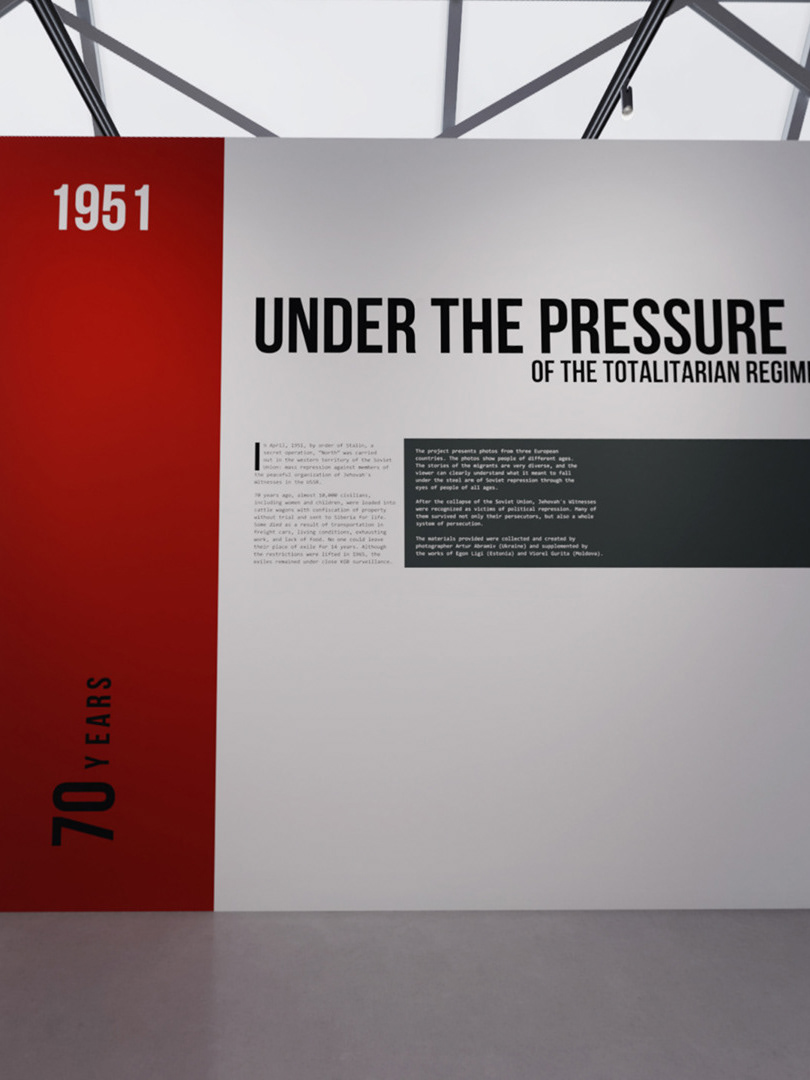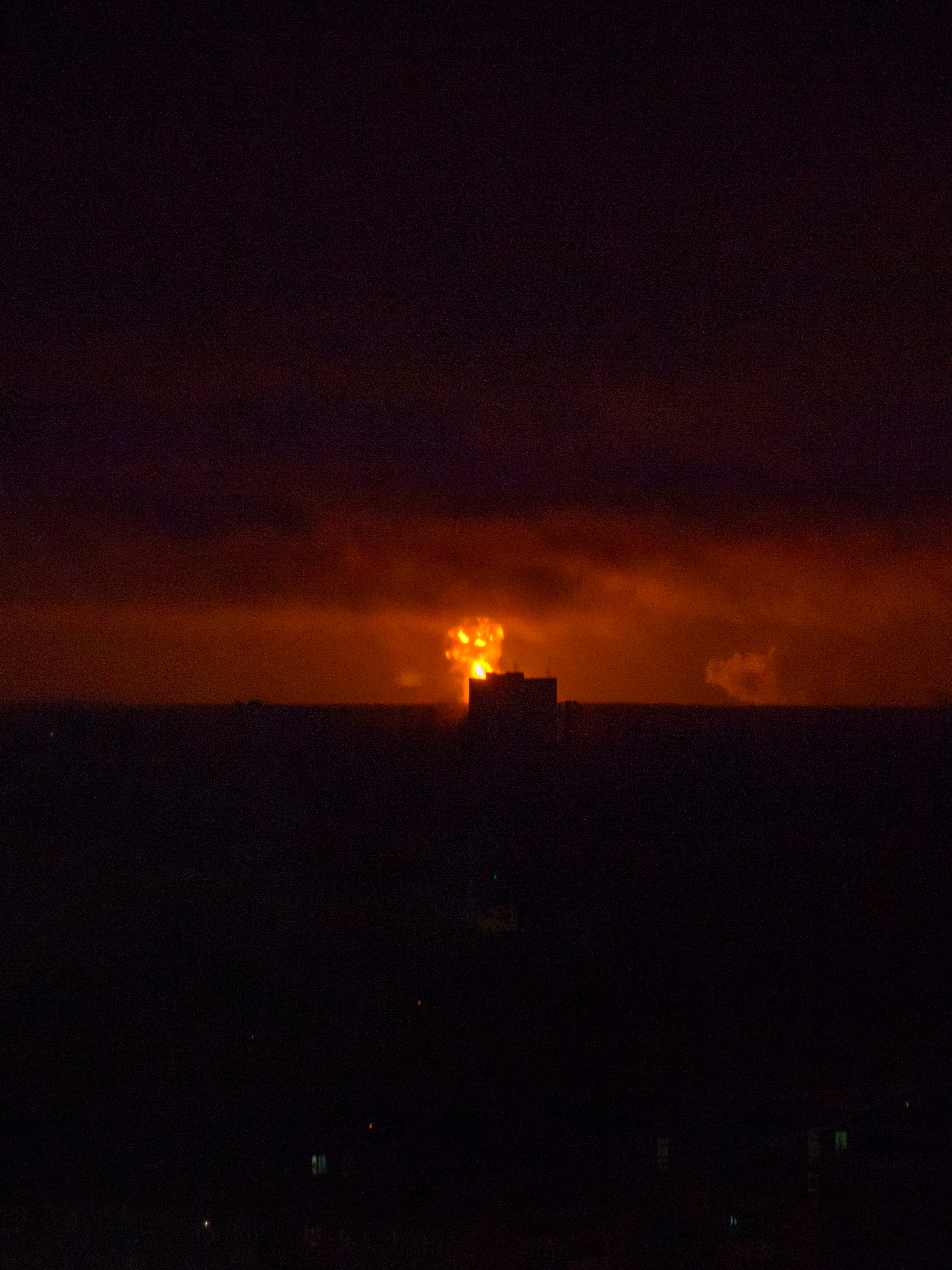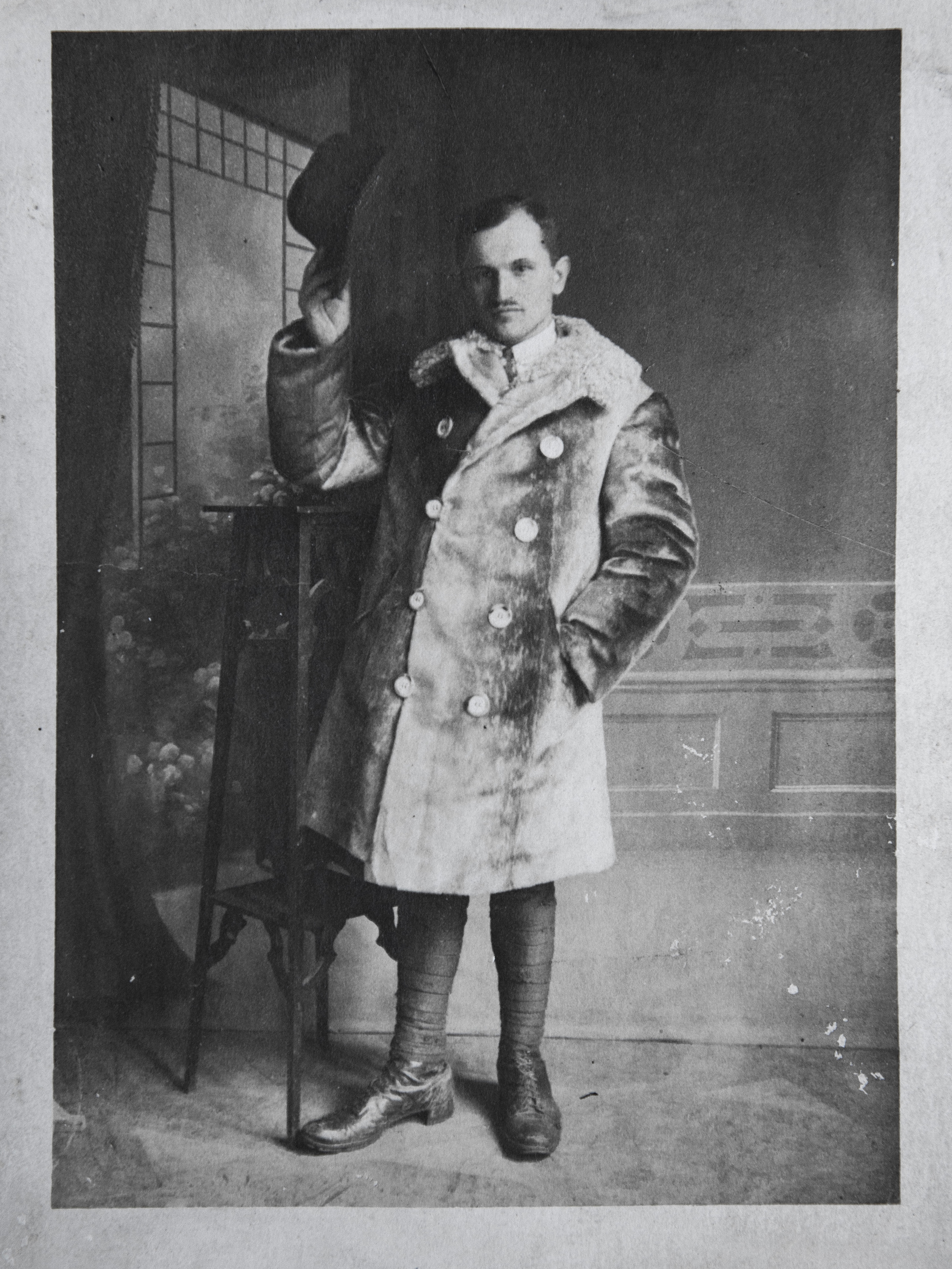Photo: 99-year-old Yurii Dolhosh at home in the village of Kholmets’, Transcarpathia 2021.
Photo source: Artur Abramiv
One Of The Last
"Two huge gendarmes purposefully hit me on the head and shoulders. They beat so hard that my skull cracked. I tried to escape, but I was caught, doused with cold water which also washed away the blood from my bloodied face, and I was beaten even harder. At that time, I was only 18 years old,” says Yurii Dolhosh, a 99-year-old native of Transcarpathia. The man went through several concentration camps and was repeatedly on the verge of death having spent about 3 years in prison.
Today, Yurii Dolhosh is one of the last Jehovah's Witnesses in the world who suffered for their
religious beliefs during World War II. From 1941 onwards, he had to oppose the Horthy regime
(Miklos Horthy, regent of Hungary (1920-1944) which combined authoritarianism, dictatorship,
and elements of parliamentary democracy, the Nazi, and communist regimes.
Today, Yurii Dolhosh is one of the last Jehovah's Witnesses in the world who suffered for their
religious beliefs during World War II. From 1941 onwards, he had to oppose the Horthy regime
(Miklos Horthy, regent of Hungary (1920-1944) which combined authoritarianism, dictatorship,
and elements of parliamentary democracy, the Nazi, and communist regimes.
Yurii Dolhosh was born in 1922 to a Rusyn-Ukrainian family in Velyki Lazy near Uzhhorod and was the youngest of five children. His native village then belonged to the Czechoslovak lands and the family was free to practice their faith. But in 1939, Transcarpathian Ukraine was annexed by Hungarian dictator Miklos Horthy. In December 1939, the activities of Jehovah's Witnesses in Hungary were banned as Hitler had already done in Nazi Germany. The Royal Gendarmerie of the time of the Hungarian regent could do anything with anyone from beating to execution. People were afraid of gendarmes.
Miklós Horthy and Adolf Hitler 1938. Source: Wikimedia Commons / Ladislav Luppa
Yurii Dolhosh first encountered the brutality of the regime in September, 1941. Two gendarmes unexpectedly entered his house in the village of Kholmets’. They came from Budapest to enroll the boys into the ranks of “Levente”, a paramilitary youth organization. The gendarmes took the boy and two other teenagers, Jehovah's Witnesses, to the village council. Yurii quickly realized that joining “Levente” contradicted his religious beliefs and explained this to a senior officer of the Royal Gendarmerie: “I do not want to be involved in things that teach me anything that is against the teachings of the Bible. I will not learn to fight and kill."
The reaction of the gendarmes to his words was horrible: “Those two were about a meter and ninety tall. One, who had an arm three times bigger than mine, took me to the room and started beating me. They abused me very cruelly by kicking me and dragging me across the floor by my hair. Two huge gendarmes purposely hit me on the head and shoulders. They beat me so hard that my skull cracked. I tried to run away, but I was quickly overtaken. As the door was closed, I was doused with cold water, causing the blood from injuries to be washed away, and I was beaten even harder. Then, I was 18 years old. I was 1.60 meters tall and weighed 50 kilograms.”
Yurii's wounds were healed at home with help from his mother: "My mother took a wet towel and compressed my head with it because my skull had been cracked, and blood was coming from that wound." Despite his serious condition, the young man survived.
Hungarian gendarmes of the Second World War with Wehrmacht officers. Source: Jegyzettár
The trial in Debrecen. Imprisonment in solitary confinement
In the winter of 1941, the young man and two of his friends were taken to court in the Hungarian city of Debrecen. During the investigation, the boys were imprisoned in solitary confinement where the water in the bucket in their cell froze from the cold. Yuri developed pleurisy from hypothermia, poor sanitation, and malnutrition. Although the circumstances were depressing, Yurii was able to read his Bible and was very happy about it. This annoyed some of the guards so one of them even wanted to take the Bible away. Yurii recalls: “But the other overseer was a good man; he didn't say anything, and the Bible wasn't taken away. And I still have that Bible.”
For three months, the boys, in cold cells, waited for a trial that turned into a mockery of justice. Hired witnesses testified falsely against the three young men. The judges noticed this and decided to release Yurii and his two friends. The prosecutor did not like that so he appealed the Dolhosh case to the Supreme Court in Budapest.
1941, in the photo Yurii is 19 years old. Photo source: Artur Abramiv
New trial. Internment until the end of the war
In the spring of 1942, Yurii visited his friends in the village of Rakoshyno. There, he was again detained by gendarmes, and they were going to massacre the boy. The head of the village intervened, but Yurii and his two friends were arrested again. They were taken to the Uzhhorod district court where they were kept in the basement for two weeks.
Judge Köszörű Károly sentenced Yurii to internment until the end of the war as an enemy of the state and a dangerous element. After the verdict was announced, the boys were sent to a stage prison in Budapest. On the way to the train station, the gendarmes tied Yurii's hands tightly with a chain and hung a belt of a backpack over his throat. One of the gendarmes began to laugh: "You are a follower of Christ; he suffered, and you will suffer too." There were provisions, clothes and a Bible in the backpack, and the belt was so tight on his throat that the boy was suffocating. A good man dared, risking his safety, to ask the gendarmes: "Where is your heart? Do you want to strangle a child?" After these words, the strap of the backpack was lowered from the boy's throat to his chest.
Interior of Keleti railway station, 1939. Photo source: FORTEPAN / György Villányi
Yurii and his friends were taken by train to Budapest. They went out at the Keleti station, dragging Yuri on a chain, the gendarmes approached the senior officer to ask where the stage prison was. The officer, seeing the abuse of the teenagers, said indignantly, “Do you have a heart, why did you take on the chain of these children? Remove the chain and handcuffs immediately! It's just children, they still grow up, and you treat them with contempt, like villains! " The gendarmes carried out the order.
The boys were taken to the stage prison on Mosonyi Street, a five-minute walk from Keleti Railway Station. A week later, they were transferred to a concentration camp called "RSHA Transport Lager Kistarcsa" in German, 15 km from Budapest.
Kistarcsa concentration camp for internees
The camp was designed for about 2,000 prisoners and was surrounded by brick walls with live barbed wire. According to Yurii, it was the easiest for him there, mostly because of the humane treatment of prisoners by the camp police. In addition, almost 40 Jehovah's Witnesses were imprisoned there for religious reasons.
Witnesses were not separated so almost all of them could sit together. Yurii said: “I was sitting with 29 fellow believers in one cell measuring 4 by 8 meters. There, we secretly held Christian meetings at night. The unity that was among us and the gathering became a source of strength and joy for me.”
Prisoners of the Jews in Kishtarcha 1944. Photo source: FORTEPAN
Subsequently, a well-known prisoner and politician, László Rajk, found refuge among a group of Witnesses. "He liked to sit with the Witnesses in the same cell because he was so sure of his safety, said Yurii Dolhosh. Often there were 29 of us, and the 30th was Laslo Raik, a communist. He respected Jehovah's Witnesses. We were on good terms with him."
László Rajk. Photo source: NOL.hu
"Death Camp" and hope for survival
The Debrecen prosecutor who had previously appealed to the Supreme Court won a harsher sentence. So, Dolhosh was once again imprisoned in a horrible stage prison in Budapest on Mosonyi Street. Jews and a growing number of political prisoners were held there. This prison was located 200 meters from Keleti Railway Station. So the prisoners heard the frequent whistles of the trains feeling their freedom so close. The gallows in the center of the courtyard reminded them that not everyone would be released from prison through the front gate. Those who had been in prison for a long time knew that the gallows had indeed been used, quite often. Yurii recalls:
"It was like a death camp. Here is a cold body, and there, under a tree, someone died. There were people who were given food, but there were also those who were not given food. Those who were given nothing died of starvation. It was good that I was frail. Although there was little food, I did not die of hunger. There were people bigger than me, and it was harder for them. Under such circumstances, prayer and meditation about God helped me to keep my inner peace.” Yurii lost up to 35 kilograms and was very exhausted.
In 1942, Dolhosh was again transferred to the Kistarcsa concentration camp. Before being sent, he underwent a follow-up medical examination which determined his chances of survival. Yurii already had pleurisy and tuberculosis of the bones. One paramedic noticed the poor condition of the boy. He advised Yurii not to admit that he was very ill because he would not be able to get out of prison alive. Yurii listened to this advice. So, he came to Kistarcsa again, hoping to survive. And the hope came true. Compared to the prison in Budapest, there was no famine in the concentration camp, and prisoners received 150 grams of bread, water, and black tea a day. Because of pleurisy, Yurii had "harder and harder to breathe" in addition to the camp, he fell ill with tuberculosis of the bones. Dolgosz once learned that he and his faithful friend had been admitted to a prison hospital in Budapest for medical examination. One of the paramedics advised Dolgosha not to go to the hospital, as he would not be able to escape. Yuri listened to the advice and encouraged his friend to do the same. However, he was so ill that he saw no other way out. His faithful friend did not return alive from the hospital.
István Vasdényey was the commander of the "RSHA Transport Lager Kistarcsa" from June 1942, and he began to restore order in the camp and build humane conditions for prisoners. In 1969, the "Yad Vashem" Institute of Israel was named the "Righteous Among the Nations." According to witness Sandor Brody at the trial of Adolf Eichmann, "hundreds and possibly thousands of Jews owe their salvation to Vasdényey."
It was thanks to his pen that Dolgosz was able to gain freedom much earlier. Yurii says:
"I worked for Officer Gyula Demjén in Kistarcsa, he respected me a lot and gave me an easy job because my illness weakened me a lot. He once said that they wanted to fire me for exemplary behavior and honesty, so they wrote a letter to Judge Károly Köszörű, my relative in Uzhhorod, who interned me. So the answer came from him: "He cannot be released, because he is dangerous for the Hungarian state." To which the officer told me, "I can't understand how such an evil judge can be that writes about you."
During the German occupation of Hungary in the spring of 1944, Dolgosz was still in the Kistarcsa concentration camp.
"A large-scale raid on Jews began, they were arrested everywhere. To free up space for them in Kistarcsa and take them to Auschwitz in gas chambers, I and other prisoners were transferred to the Garany concentration camp, now in Slovakia."
After Yurii was taken out of Kistarcsa, the most dramatic events in the history of the Holocaust began, as the camp was used by the Third Reich as a transit camp from which thousands of prisoners were sent to death camps. A few months later, the concentration camp became famous for its unprecedented disobedience to Adolf Eichmann's order to exterminate the Jews, which hurt his image.
István Vasdényey was the commander of the "RSHA Transport Lager Kistarcsa" from June 1942, and he began to restore order in the camp and build humane conditions for prisoners. In 1969, the "Yad Vashem" Institute of Israel was named the "Righteous Among the Nations." According to witness Sandor Brody at the trial of Adolf Eichmann, "hundreds and possibly thousands of Jews owe their salvation to Vasdényey."
It was thanks to his pen that Dolgosz was able to gain freedom much earlier. Yurii says:
"I worked for Officer Gyula Demjén in Kistarcsa, he respected me a lot and gave me an easy job because my illness weakened me a lot. He once said that they wanted to fire me for exemplary behavior and honesty, so they wrote a letter to Judge Károly Köszörű, my relative in Uzhhorod, who interned me. So the answer came from him: "He cannot be released, because he is dangerous for the Hungarian state." To which the officer told me, "I can't understand how such an evil judge can be that writes about you."
During the German occupation of Hungary in the spring of 1944, Dolgosz was still in the Kistarcsa concentration camp.
"A large-scale raid on Jews began, they were arrested everywhere. To free up space for them in Kistarcsa and take them to Auschwitz in gas chambers, I and other prisoners were transferred to the Garany concentration camp, now in Slovakia."
After Yurii was taken out of Kistarcsa, the most dramatic events in the history of the Holocaust began, as the camp was used by the Third Reich as a transit camp from which thousands of prisoners were sent to death camps. A few months later, the concentration camp became famous for its unprecedented disobedience to Adolf Eichmann's order to exterminate the Jews, which hurt his image.
Budapest, arrest of Jews. Hungarian and German soldiers drive the arrested Jews to the city theater. October 1944. German Federal Archive (Deutsches Bundesarchiv)
Transit Concentration Camp Garany
In the spring of 1944, Dolhosh was transferred to a concentration camp for internees in the village of Hraň, 80 kilometers from his home. The camp was established on the farm of the castle of Count Almashi and accommodated more than seven hundred people. It was surrounded by an electric fence around the perimeter. After the German occupation, it was used as a transit camp for Jews.
"The Count’s farm was turned into a concentration camp for slaves. Partitions were erected on the premises, making small cells for prisoners which could accommodate only two people. What we wore, that’s what warmed us up. “There was nothing in the cell except the bunks”, said Yurii Dolhosh. I could say that it was one of the worst camps I've been to. It was difficult in every way, both mentally and physically. This camp was full of Jews who were prepared for the gas chambers. At night, the guards spread the cover, and the Jews forcibly took off their rings, watches, clothes, and everything down to nakedness. Then they were given used stuff, regardless of size. They were taken to Auschwitz. So, we never saw those Jews again ...
In the camp, sick people were separated from the rest into one large cell. It is clear why I did not want to go there. There were patients with tuberculosis and other deadly diseases. It was supervised by a young police officer. This policeman took care of me. He allowed me to stay in my cell and brought me milk personally because milk was given to those who were sick. And he used to bring me twice as much as a regular portion. "
"Selection" of Hungarian Jews on the ramp at Auschwitz-II-Birkenau in German-occupied Poland, May/June 1944, during the final phase of the Holocaust. Jews were sent either to work or to the gas chamber. Source: Yad Vashem
"We are all here doomed to die"
One day, in line for food at the camp, Dolhosh was bullied by a gendarme. The gendarme kicked him, and the blow could easily have been fatal due to the fragility of the bones from tuberculosis. So, despite his caution and previous experience, Yurii decided to go to a camp doctor who turned out to be a Jewish prisoner.
"I was so weak that when that doctor opened the door, I fell across the threshold right in front of him. Then he took me and put me on the couch and began to examine and sadly said:'What to do with you? We are all doomed to die here.’ He said so because he thought I would be taken to Auschwitz as well. Then he came to my defense in front of the camp guards saying that I urgently needed to be taken to the hospital."
Dolhosh, accompanied by one policeman, was released to the hospital in the city of Satoraljaujhely. The distance to the rescue hospital was 25 kilometers, and the sick boy had to walk there. Fortunately, they barely walked a few kilometers as a cart passed by. The policeman stopped the cart and they, together with Yuriy, got on it.
They arrived at the hospital around 10 pm. There, Dolhosh's body was plastered to prevent fractures and damage to internal organs and blood vessels, and tuberculosis injections were started. Two weeks later, Yurii was already crying because bedbugs had gotten into the plaster form and were literally eating the boy. The form was cut, and the bedbugs were destroyed. In the hospital, fellow believers found out about the boy. They constantly came to him, brought him food and took care of his basic necessities.
Shortly after the plaster was applied, the chief doctor wanted to send Yurii back to the concentration camp, saying that they had already done their job. That would have meant certain death. However, one of Yurii's fellow believers asked the chief doctor's mistress to influence doctors that Dolhosh to be left in the hospital. Yurii was hospitalized in plaster for 5 months.
Yurii's father worked as a coachman for the chief judge. While Dolhosh was in the hospital, his father kept begging Judge Károly Köszörű to overturn his sentence. The war was coming to an end, so in October 1944 the chief judge canceled the boy's internment. On October 22, 1944, at the hospital, the young man received a letter from Gyula Demjén with the following information: “Dear Dolhosh, your internment has already been terminated. You are free, and you can go home."
Gaining strength, together with the plaster mold, which became his new bed, Yurii returned home to the village of Kholmets. A few days later, the Red Army entered Uzhhorod. For another eight years after these events, Yurii fell asleep in a plaster cast every night.
Gaining strength, together with the plaster mold, which became his new bed, Yurii returned home to the village of Kholmets. A few days later, the Red Army entered Uzhhorod. For another eight years after these events, Yurii fell asleep in a plaster cast every night.
Soviet Era
We did not rejoice in freedom for a long time because the communist regime began to persecute Christians. In 1947-1950 alone, 1,048 Jehovah's Witnesses were arrested in the western Soviet republics. In 1951, the most massive religious repression in the history of the USSR took place. At that time, nearly 10,000 Jehovah's Witnesses were deported from the western territories of the Soviet Union to Siberia. However, for unknown reasons, believers were not deported from Transcarpathia. Yurii Dolhosh remained in his home village, as did 429 other families of Jehovah's Witnesses.
Yurii tells about that time: “After my arrival, the Soviet authorities also began to persecute me.
One day a policeman, a very good acquaintance, said: “Yurii, be careful, because in the evening a KGB officer was watching your house. I know this because I spied with him. When you hear a dog barking at night, don't go outside because they plan to kill you.”
Another time during interrogation, an officer told me, "I will kill you like a dog. And you will not agitate anymore." I was spied upon and often interrogated. The KGB even came in and out of my window."
Fortunately, Dolhosh managed to escape Soviet-era imprisonment because, after going through a brutal school of survival during the war, he "learned to be perceptive in a variety of situations."
Yurii Dolhosh in Soviet times, 1950s. Photo source: Artur Abramiv
Present
Today, comparing totalitarian systems, the almost century-old man says: "The Nazi and Horthy regimes tortured more physically, and the Soviet regime, psychologically and morally."
Yurii is glad that he did not waver under the pressure of the three regimes and was able to withstand many trials, remaining faithful to them. Unfortunately, the arrests severely damaged Dolgosz's health, which he said forced him to "live in hospitals." He sadly says that the worst ordeal for him is to experience senile infirmities. Despite his poor health, he is known as a friendly and intelligent man, with a good sense of humor, and does not hold a grudge against his persecutors.
Five years ago, Yurii jokingly agreed with the doctor of the local hospital that he would come for an appointment when he turned 100 years old. Now he is 99.
It is nice to see that the Carpathian long-lived meeting his hundredth year of life with dignity and a bright mind. Today Yuri lives under the care of his relatives in the Transcarpathian village of Kholmets, his favorite book is still the Bible.
Five years ago, Yurii jokingly agreed with the doctor of the local hospital that he would come for an appointment when he turned 100 years old. Now he is 99.
It is nice to see that the Carpathian long-lived meeting his hundredth year of life with dignity and a bright mind. Today Yuri lives under the care of his relatives in the Transcarpathian village of Kholmets, his favorite book is still the Bible.
Yuri holds in his hands the Bible that was with him in all the persecution. Photo: Artur Abramiv
Limb
László Rajk, became Minister of the Interior and Deputy Secretary-General of the Communist Party in 1946. From 1948 to 1949 Minister of Foreign Affairs. In 1949 he was accused of treason, espionage, and attempting to overthrow the communist regime of Matthias Rakoshi. Executed in 1949. The first arrest of Jehovah's Witnesses in communist Hungary took place in 1950.
One of the most brutal gendarmes who tortured Dolgosh in 1941, named Hernadi, fled to Canada at the risk of retaliation from other victims of his violence, where he ended his life in a psychiatric hospital.
Yad Vashem Award Ceremony to István Vasdényey. Photo source: ujkor.hu
The commander of the camp, István Vasdényey, was imprisoned by the Soviet authorities in the Gulag camps for about 8 years. In 1964, Vasdényey managed to emigrate to the United States, where he lived at the expense of the Jews he saved.
In 1961, the Mossad was captured and secretly transported from Argentina by Adolf Eichmann, "one of the worst Nazi war criminals responsible for the so-called" Final Solution to the Jewish Question - the Extermination of 6 Million European Jews. " He was tried in Jerusalem from 1961 to 1962. At the trial, Eichmann justified himself by saying that he did everything on command. However, when arguing in court about the events in the Kistarcsa and Sárvár concentration camps, Eichmann said he did not remember the events.
Adolf Eichmann Stands with Israeli Police During Trial (Original Caption) 5/29/1962-Jerusalem, Israel- Adolf Eichmann, accused Nazi mass murderer, stands in his bullet-proof glass cage to hear Israel's Supreme Court unanimously reject an appeal against his death sentence. With him are two armed guards. The verdict meant that only Israeli President Itzhak Ben-Zvi could save the 56 year old Eichmann, charged with the murder of six million Jews, from the gallows. In the foreground is defense attorney Robert Servatius.
Photo source: Bettmann Archive/Getty Images
Photo source: Bettmann Archive/Getty Images
It is estimated that thousands of Jehovah's Witnesses suffered from far-right regimes during World War II for their position of neutrality. In Europe, about 12,000 were imprisoned in Nazi concentration camps and prisons, and about 1,500 died from forced labor, torture, starvation, cold, disease, or extreme exhaustion. Some Witnesses died in gas chambers or fell victim to medical experiments.
About 400 were executed by guillotine, shot, or hanged.
Their persecution was also discussed at the Nuremberg tribunal as the only religious group that was purposefully persecuted by the Nazi regime.
Tens of thousands of Jehovah's Witnesses have suffered at the hands of the Soviet regime.
Today, the activities of Jehovah's Witnesses are legal in the world, but there are a few where activities are restricted or prohibited. As of December 2021, more than 140 Jehovah's Witnesses worldwide are serving prison sentences for religious reasons.
About 400 were executed by guillotine, shot, or hanged.
Their persecution was also discussed at the Nuremberg tribunal as the only religious group that was purposefully persecuted by the Nazi regime.
Tens of thousands of Jehovah's Witnesses have suffered at the hands of the Soviet regime.
Today, the activities of Jehovah's Witnesses are legal in the world, but there are a few where activities are restricted or prohibited. As of December 2021, more than 140 Jehovah's Witnesses worldwide are serving prison sentences for religious reasons.
The defendants at the Nuremberg trials. Front row (L-R): Hermann Goering, Rudolf Hess, Joachim Von Ribbentrop, Wilhelm Keitel and Ernst Kaltenbrunner. Back row (L-R): Karl Doenitz, Erich Raeder, Baldur von Schirach and Fritz Sauckel.1 January 1946.
Photo source: Bettmann Archive/Getty Images
Photo source: Bettmann Archive/Getty Images










